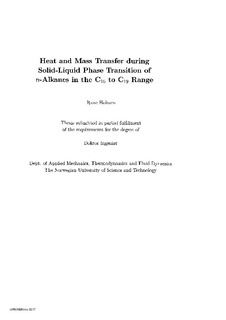| dc.contributor.author | Holmen, Rune | nb_NO |
| dc.date.accessioned | 2014-12-19T11:24:52Z | |
| dc.date.available | 2014-12-19T11:24:52Z | |
| dc.date.created | 2002-09-02 | nb_NO |
| dc.date.issued | 2002 | nb_NO |
| dc.identifier | 125377 | nb_NO |
| dc.identifier.isbn | 82-471-5477-3 | nb_NO |
| dc.identifier.uri | http://hdl.handle.net/11250/231244 | |
| dc.description.abstract | The main goal of this project has been to study heat and mass transfer during solid-liquid phase transition of n-alkanes in the C16 to C19 range. Phase transitions of both mixtures and pure components have been investigated.
All experiments and simulations have been performed without any convection.
Thermal conductivities have been determined at the melting point for solid and liquid unbranched alkanes ranging from C16 to C19. An assessment of the error of the method has been performed.
The measurements of solid conductivities are in accordance with measurements reported previously and confirm the applicability of the method. Liquid conductivities are higher than extrapolated values from the literature. The enhanced conductivity is believed to be caused by structural changes close to the melting point which is not taken into account when extrapolating values from the literature.
Experiments have been performed for the purpose of investigating the freezing of mixtures of n-alkanes in the C16 to C19 range. The positions of the solid-liquid interfaces have been measures as freezing occured.
Calculations of the ratio of liquid and solid conductivities show that the solid structure of mixtures of the investigated n-alkanes is predominantly in a rotator structure at the temperatures investigated. There are indications of a transformation into an orthorhombic structure at lower temperatures.
The temperature on the solid-liquid interface have been measured, and compared with calculated values from chapter 4. The temperature of the interface is represented better by the measured interfacial temperatures than by the calculated interfacial temperatures.
The experimental results indicate that the diffusion of heat is the limiting mechanism of phase transition. This result in a homogeneous liquid composition.
A numerical model has been developed in order to simulate the experimental freezing of mixtures. The model represents the results of the experiments within the limit of the uncertainties of the physical properties and the interfacial temperatures.
Also the numerical model suggests that the solid structure is predominantly in a rotator structure at the temperatures investigated. The properties of the rotator phase are represented better by physical properties of solid C17 than by molar averages.
The results from the simulations support the hypothesis that the limiting mechanism of deposition is the diffusion of heat to the interface. This implies that further work should focus on the determination of the thermophysical properties of solid fax instead of further development of models for the solid liquid equilibrium. | nb_NO |
| dc.language | eng | nb_NO |
| dc.publisher | Fakultet for ingeniørvitenskap og teknologi | nb_NO |
| dc.relation.ispartofseries | Dr.ingeniøravhandling, 0809-103X; 2002:79 | nb_NO |
| dc.title | Heat and Mass Transfer during Solid-Liquid Phase Transition of n-Alkanes in the C16 to C19 Range | nb_NO |
| dc.type | Doctoral thesis | nb_NO |
| dc.source.pagenumber | 161 | nb_NO |
| dc.contributor.department | Norges teknisk-naturvitenskapelige universitet, Fakultet for ingeniørvitenskap og teknologi | nb_NO |
| dc.description.degree | dr.ing. | nb_NO |
| dc.description.degree | dr.ing. | en_GB |
